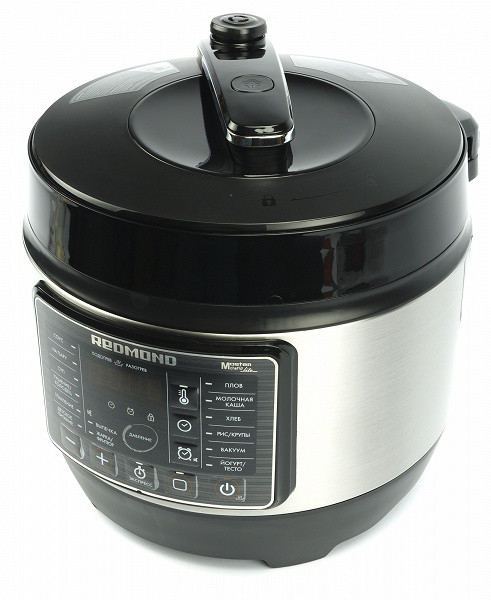
It remains for us to find out the effectiveness of the declared functions in practice. Let's get started.
Characteristics
| Manufacturer | Redmond |
|---|---|
| Model | RMC-PM504 |
| Type | multicooker-pressure cooker |
| Country of origin | China |
| Guarantee | 12 months + 1 year of additional service when registering the device on the website |
| Service life * | 5 years |
| Power | 900 W |
| Bowl volume | 5 l (useful volume 3.5 l) |
| Bowl coating | non-stick |
| Body material | metal, plastic |
| Peculiarities | removable lid, removable steam valve |
| Control type | electronic |
| Display | LED |
| Protection system | steam release valve, shut-off valve, temperature fuse, overpressure sensor |
| Maintaining the temperature of prepared dishes | up to 12 o'clock |
| Reheating food | up to 12 o'clock |
| Delayed start | up to 24 hours |
| Number of automatic programs | 15 |
| Programs in pressure cooker mode | rice/cereals, soup, stewing/aspic, simmering, pilaf, steamed |
| Programs in multicooker mode | baby food, milk porridge, vacuum, bread, pastries, yogurt/dough, frying/deep frying, sauce, express |
| Additional functions | «Masterchef Light», control panel lock, sound signal disablement |
| Accessories | container with stand for steaming, yogurt jars with stand, measuring cup, ladle, flat spoon, recipe book |
| Net weight | 5.5 kg |
| Dimensions (W×H×D) | 290×310×285 mm |
| Length of network cable | 1 m |
* Contrary to popular belief, this is not a period after which the device will necessarily break down. However, after this period, the manufacturer ceases to bear any responsibility for its functionality and has the right to refuse to repair it, even for a fee.
Equipment
The packaging of the Redmond multicooker is, as always, attractive and made with high-quality full-color printing. On the edges of the durable cardboard box there are photos of the device itself, a delicious dish prepared with its help, and a stylish design to attract attention. Next to the bright images are the company logo, the full name of the model, a list of its main advantages, configuration, as well as a list of technical characteristics and information about the manufacturer.
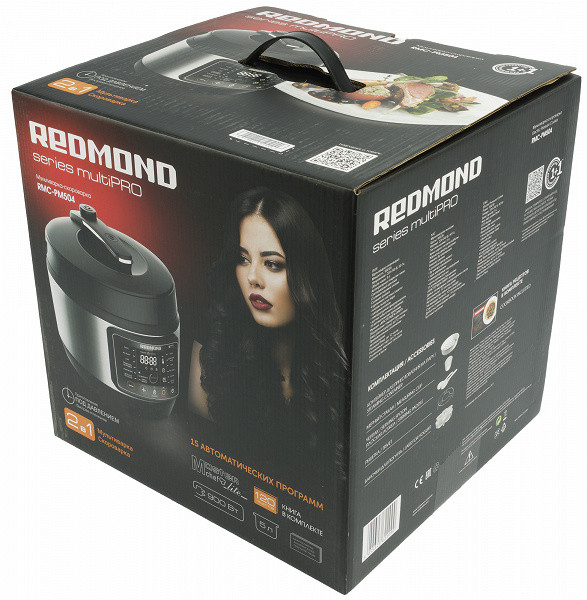
Inside, the device and all its components are tightly squeezed in polyethylene bags by a pair of foam inserts.
Opening the box, we found inside:
- The multicooker-pressure cooker itself with a bowl installed in it
- A container for steaming with a stand
- A measuring cup
- A ladle and a flat spoon
- A yogurt jar with a stand
- A recipe book, instructions, and a service book
At first glance
The appearance of the Redmond RMC-PM504 is almost no different from a regular multicooker. The only visual sign of belonging to the pressure cooker family is the removable steam valve on the handle protruding from the lid. In addition, it is worth noting that the device is significantly heavier than a standard multicooker.
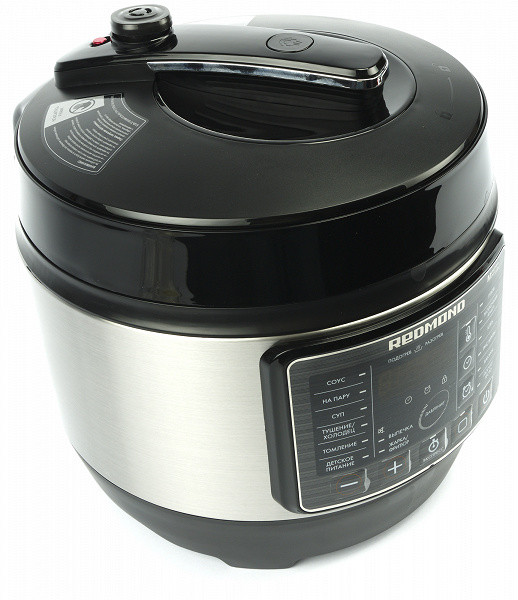
The increased weight of the device is due to the built-in metal outer bowl, which is absent in conventional multicookers, as well as a heavier lid with a metal insert inside. Despite this, the device retains its compact dimensions.
Most of the body is covered with a smooth sheet of stainless steel, the base is made of black matte plastic, and the massive lid is also made of plastic, but with the addition of a glossy surface. The multicooker looks quite attractive.
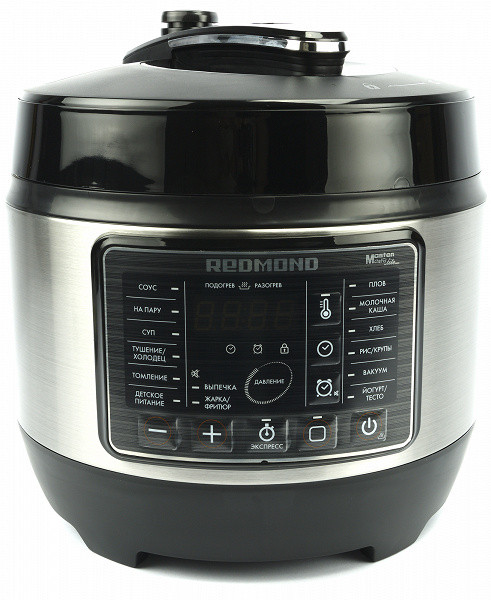
The control panel, equipped with mechanical buttons and a display, is located in the center of the front side and protrudes slightly from the case.
The cover is hinged and removable. To unlock it, you need to turn it to the right, and to firmly fix it in the closed position, turn it to the left, ensuring a tight connection with the case.
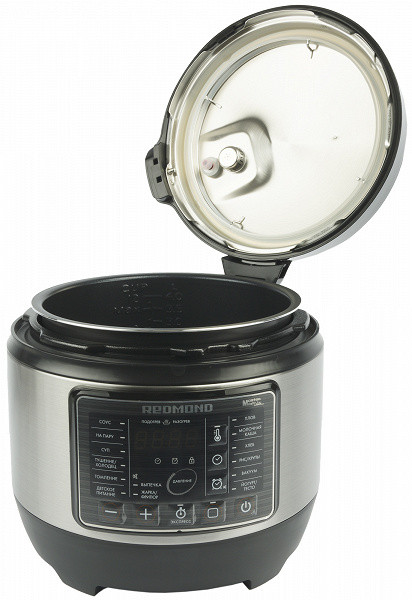
Removing the heavy lid from the body requires only one action: when it is open, simply turn it upwards and the lid will come out of the hinge.
On the top of the removable lid there is a steam valve, a mechanical red pressure indicator and a button for opening the steam valve, located on the handle. Next to the pressure indicator and the handle there are stickers with warning inscriptions.
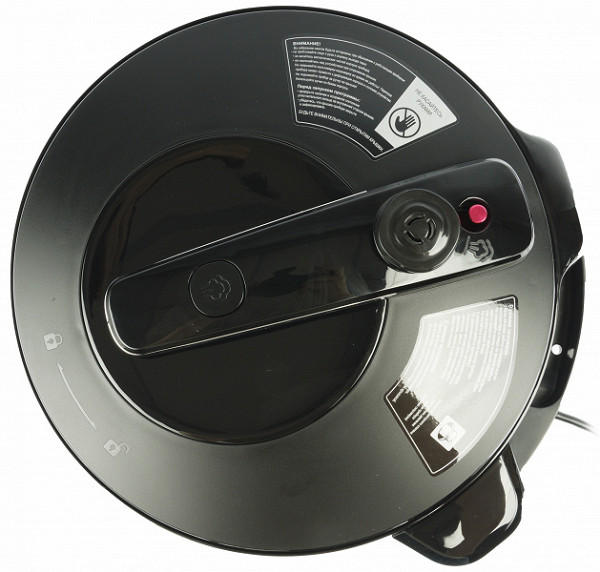
When the pressure is released, the steam valve slightly moves to the side, releasing a stream of hot steam upward. The pressure indicator has two positions: raised and lowered. When the pressure is increased, it rises slightly above the body, and after the pressure is released, it quickly drops down.
On the inside of the lid, a removable silicone sealing ring is fixed around the perimeter, which is held in place by a metal arc. It is easy to remove for cleaning. Nearby are a rubber shut-off valve and a metal protective mesh of the steam valve — both parts are also removable.
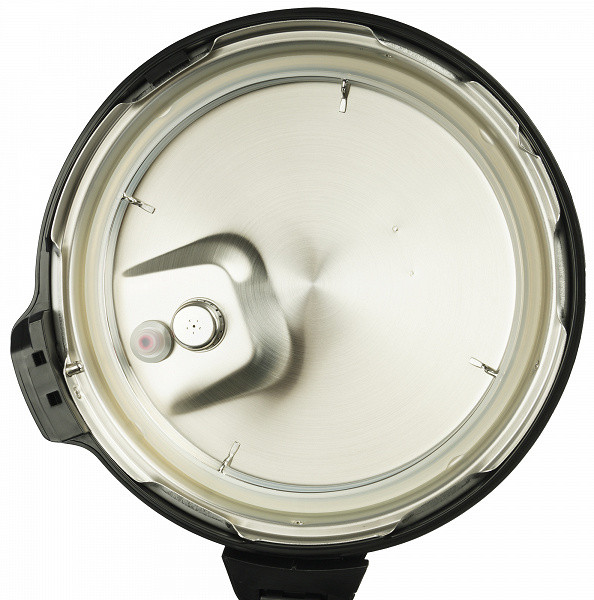
On the back of the case there is a container for collecting condensate made of transparent white plastic. Below on the metal part there is a sticker with the serial number and production date.
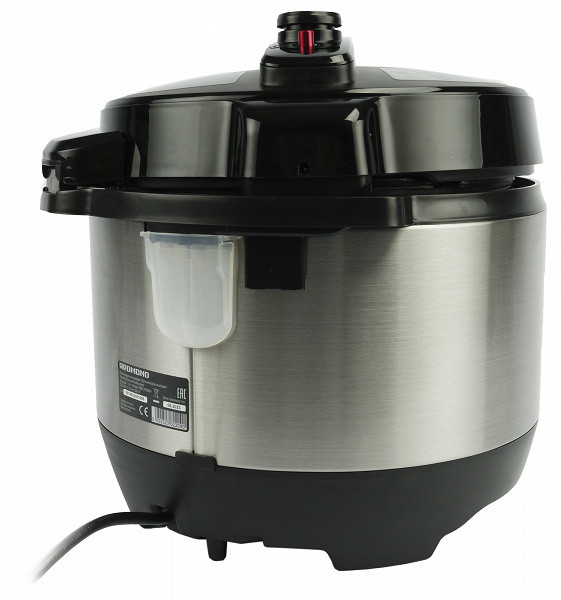
The non-removable power cord comes out of the bottom of the base.
On the bottom of the device there are four plastic feet in the form of rectangular protrusions, two of which have rubber inserts, and one is round. On the sides of the base there are cutouts for easy grip when carrying. In the center there are ventilation holes.
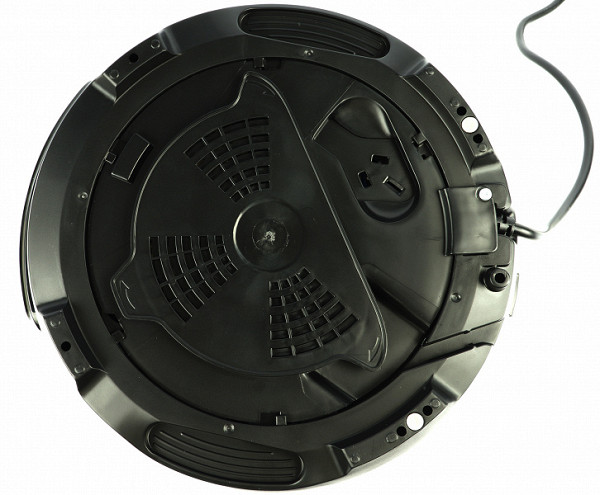
The bowl has a non-stick coating and high sides. As usual, the volume of 5 liters stated in the documentation is the maximum capacity, but only 3.5 liters can be poured up to the Max mark. The scale of the bowl indicates the risks with a step of 0.5 liters, starting from 1 to 4 liters.
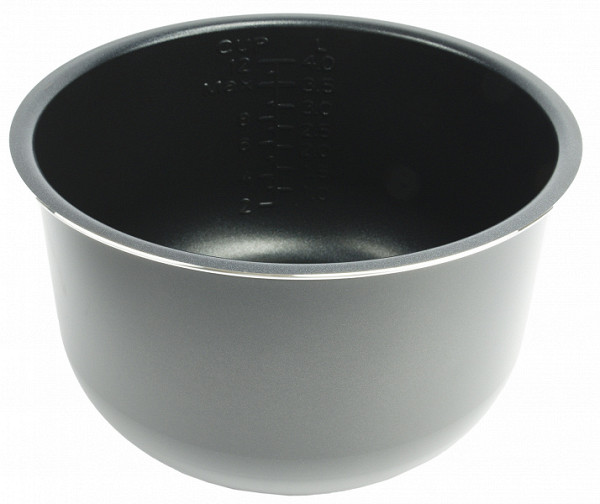
The working chamber of the multicooker: metal side walls with a protective coating, a heating element at the bottom and a spring-loaded temperature sensor.
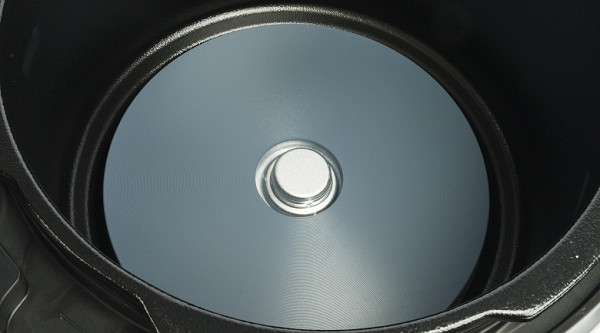
The working chamber of the multicooker: metal side walls with a protective coating, a heating element at the bottom and a spring-loaded temperature sensor.
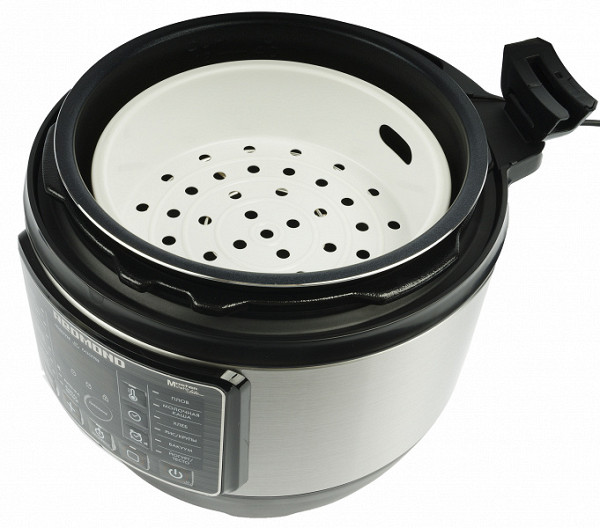
The container in the bowl should be placed on a special metal stand.
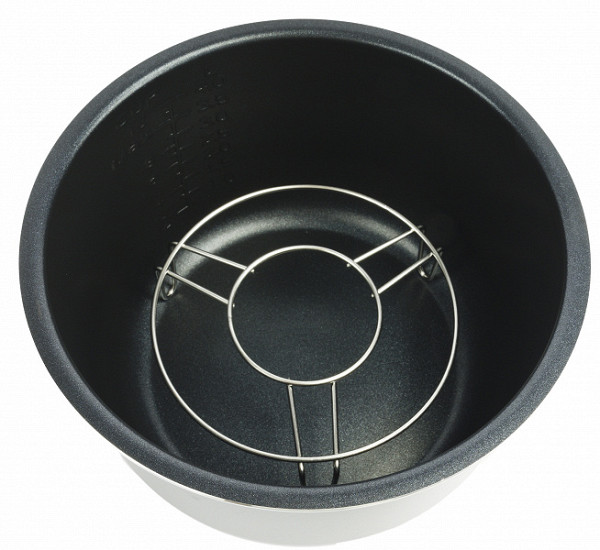
The multicooker set also includes a flat spoon, a ladle and a small measuring cup with a capacity of 160 ml.
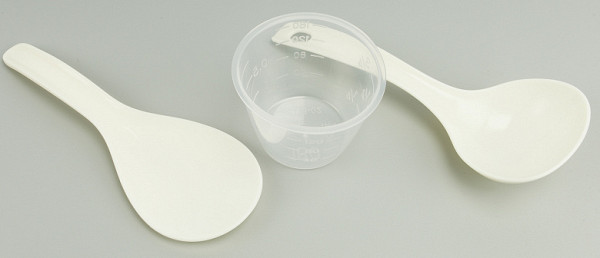
To prepare yogurt, the set includes 5 plastic jars with lids. They are installed in special cells of a plastic stand, which is equipped with small legs with rubber inserts. For ease of carrying, the design is equipped with a handle in the middle.
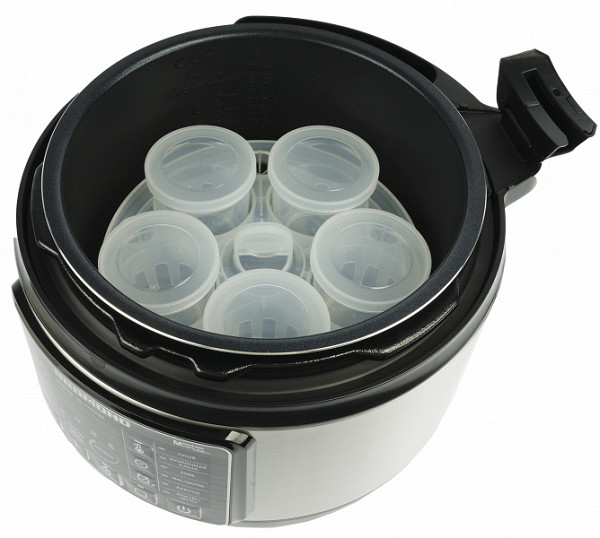
Instructions
Printed materials for Redmond RMC-PM504 include a user manual, service book and illustrated recipe book.
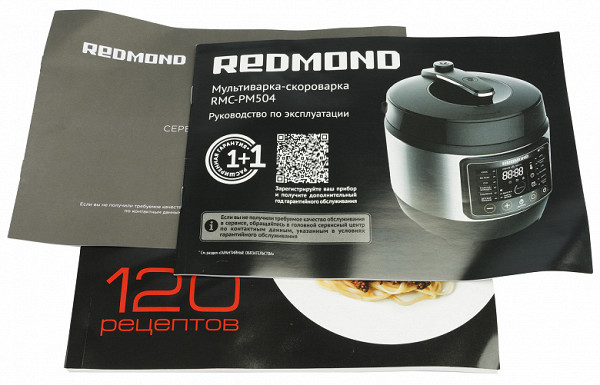
The 27-page user manual is presented in two languages: Russian and Kazakh. The brochure describes in detail the structure of the multicooker, provides all the important aspects of safe operation and management. The document also contains recommendations on choosing cooking parameters, using temperature modes depending on the type of products, advice on caring for the device and troubleshooting possible problems before contacting the service center.
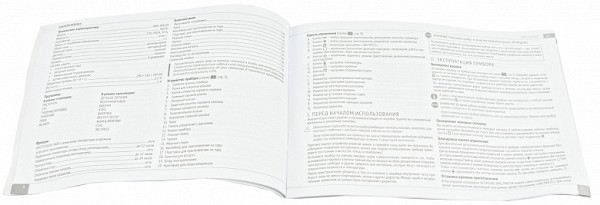
The instructions are written in simple and understandable language, contain tables and diagrams, which makes it easier to understand the information.
The book with 120 recipes looks attractive and encourages you to start cooking right away. It will be useful for a novice cook in creating a menu for the family. The recipes are given in detail with an indication of the program and a list of ingredients.
Control
To assess the complexity of the controls, we decided to try to figure it out without the instructions. It turned out that it is not so easy to do — it is better to use the device the first couple of times, focusing on the manual, since there are many nuances.
The Redmond RMC-PM504 control panel is equipped with eight mechanical buttons and many indicators with designations of functions and auto programs. The display shows current parameters, such as the remaining time, the selected temperature and cooking time, as well as the pressure level, if this function is active in the program.
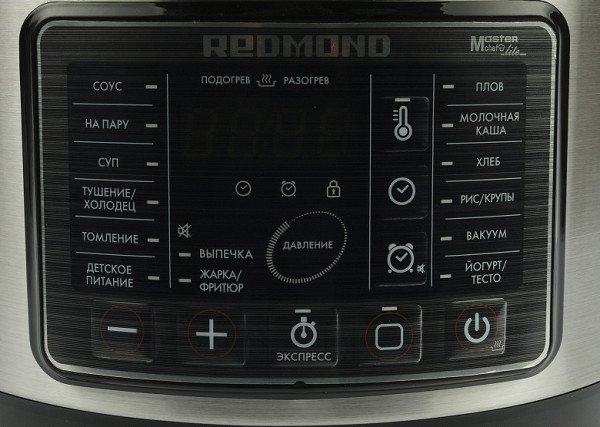
In the pressure cooker mode (cooking under pressure), 6 programs are available: «Rice/Cereals», «Soup», «Stewing/Aspic», «Simmering», «Pilaf» and «Steam». During operation of these programs, the steam valve must be installed in place. It is not possible to adjust the temperature in these modes, and the instructions do not contain information about preset temperatures.
The cooking time can be changed in 1-minute increments:
— «Rice/Cereals» and «Steam» — from 1 minute to 2 hours
— «Pilaf» — from 1 minute to 3 hours
— «Soup», «Stewing/Aspic» — from 1 minute to 4 hours
— «Simmering» — from 1 minute to 5 hours
The following programs are available in the multicooker mode: «Baby food», «Milk porridge», «Vacuum», «Bread», «Baking», «Yogurt/Dough», «Frying/Deep frying», «Sauce» and «Express». Before starting these programs, the steam valve must be removed. The temperature is adjustable only in the «Baking», «Frying/Deep Frying» and «Sauce» programs in the range from 35 to 180 °C in 1 °C increments, and in the «Vacuum» program — from 40 to 100 °C in the same increments.
The cooking time can be adjusted in 1-minute increments:
— «Frying/Deep Frying» — from 1 minute to 1 hour
— «Bread», «Baking», «Milk porridge», «Baby food» — from 1 minute to 4 hours
— «Sauce» — from 1 minute to 5 hours
— «Vacuum» — from 1 minute to 10 hours
— «Yogurt/Dough» — from 10 minutes to 12 hours
The «Express» program automatically ends cooking after the water has boiled away, ideal for crumbly porridges on water.
To start cooking, connect the appliance to the mains, select a program using the “+” and “-” buttons, change the time and set a delayed start if necessary, and then press the “On/Off” button (the rightmost one in the bottom row). To cancel the program and reset the settings, use the second button from the right. The same button activates or deactivates the heating function.
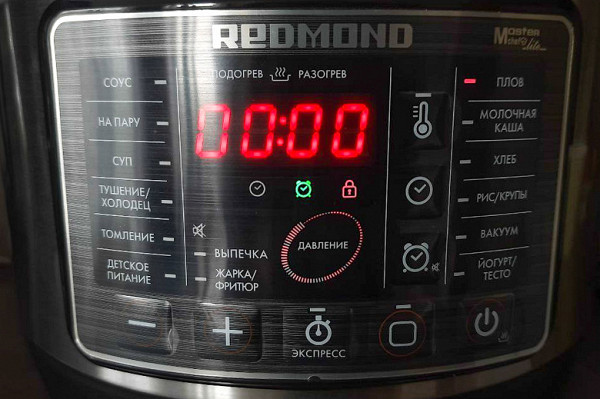
The auto-keep-warm function is activated automatically at the end of the cycle and maintains the temperature of the finished dish within 70-75 degrees for up to 12 hours. To turn off the auto-keep-warm function during operation, simply press the «On/Off» button.
The delayed start function allows you to set the time interval from 1 minute to 24 hours in 1-minute increments.
Before starting the program, you can turn off the sound signals at any time by pressing and holding the temperature control button. You can also lock the control panel by simultaneously pressing and holding the "+" and "-" buttons.
The numbers on the display are clear and large, bright enough in artificial light, but the indicators next to the programs look dim, which makes them difficult to read when switching between programs.
Operation
Before using the multicooker, the manufacturer recommends wiping the body of the multicooker first with a damp cloth and then with a dry cloth, and rinsing all removable parts and accessories with warm water and drying. The device should be installed at a sufficient distance from wallpaper, decorative coverings and other electrical appliances to avoid damage from hot steam. We followed these recommendations.
The lid fastening system turned out to be unusual: although it is removable, which simplifies cleaning, the loop on which the lid is held does not have a lock. This creates free movement of the lid in the open position, and at first it was often removed completely. When the program is running, the device signals with a melodic trill if the lid is not closed or not fully latched.
The removable steam release valve is also attached quite freely and is easily removed and inserted back, although it does not fit into the socket all the way (this is normal, as it turned out). Despite the initial suspicions, no safety issues arose.
Of the minor drawbacks, we note that the included spoons could be longer. Also, the very hot bowl can only be removed with a towel or potholders, hooked by the thin sides, which is not very convenient; the presence of handles would be more convenient.
Otherwise, working with the Redmond RMC-PM504 resembles using any other multicooker. Combining the functions of two devices is convenient, since there is no need to use separate devices for cooking, baking, yogurt or sous-vide. Automatic modes are well thought out, have adequate preset parameters and most of them can be flexibly adjusted.
Cooking under pressure turned out to be effective. The pressure level is unknown and cannot be adjusted manually, but, apparently, the manufacturer took care of reasonable settings — all dishes cooked this way turned out great and much faster than without pressure.
If a dish is cooked in a regular multicooker for about half an hour, then there is no point in setting it to the pressure cooker program, since the time to build up pressure, cool and release steam makes the difference imperceptible. However, a noticeable effect is observed with dishes that under normal conditions require long cooking.
The instructions warn that for pressure cooking, the bowl must be filled with water or other liquid at least ⅕ and no more than ⅘ of the total volume. When cooking products that can swell or emit foam, the volume should not exceed ⅗. It is also worth remembering about prohibited products, the foam and splashes of which can clog the valve: pasta, pearl barley, oatmeal, semolina, millet, crushed peas, noodles and compotes.
Care
The body of the multicooker should be wiped first with a damp cloth and then with a dry cloth, avoiding water getting inside the working chamber.
After cooking, the lid should be disassembled: the valve and silicone ring can be simply washed under running water, and the non-detachable parts of the lid should be wiped with a damp cloth or napkin. The instructions do not mention the possibility of washing individual elements of the multicooker in the dishwasher, but we assume that the plastic accessories will survive machine washing without problems.
Our measurements
The maximum power of the multicooker was recorded in the Express mode and was 960 W.
In the pressure stewing mode, the device consumed 0.455 kW h for 1 hour at a maximum power of 953 W. 0.302 kW h were consumed for 3 hours of baking bread, and the maximum power was 958 W. In the Yogurt mode, the consumption was 0.055 kW h for 12 hours of operation at a maximum power of 407 W.
The body of the multicooker did not heat up above 35-40 degrees in any mode.
The device operates almost silently, only occasionally light clicks of the heating element are heard in certain programs. Noticeable noise occurs only when manually releasing steam at the end of the program.
The sound signals accompanying the pressing of buttons and notifications about the end of the cycle are of moderate volume.
The power cord, according to our measurements, turned out to be slightly longer than indicated — 120 cm.
Practice tests
Yogurt
The Redmond RMC-PM504, as we mentioned, comes with handy yogurt pots and a special mode for making yogurt, so we decided to take advantage of this feature. We used 550 ml of 3.2% fat milk and 120 g of thick plain yogurt with 2% fat.
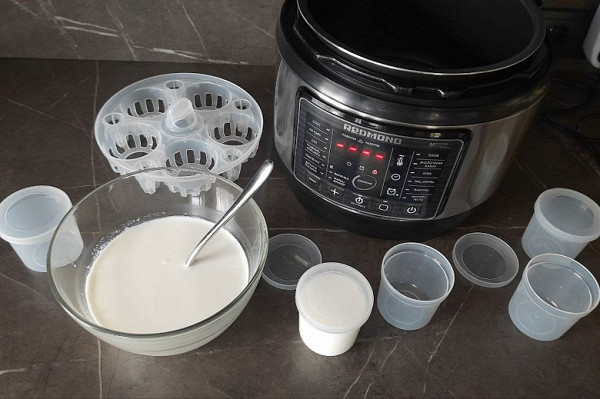
Milk at room temperature was poured into a glass bowl, yogurt was added, mixed with a whisk and poured into jars. Exactly 140 ml fit to the line where the container expands.
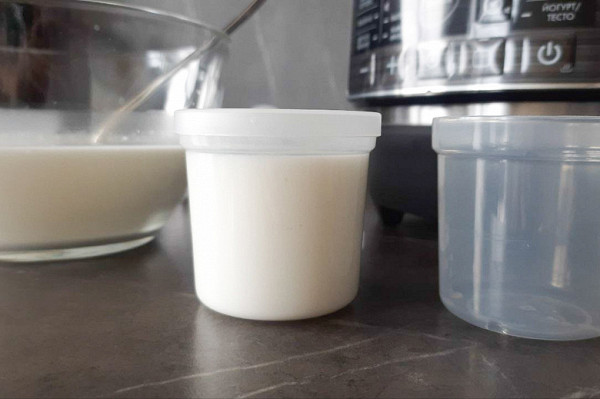
We placed the jars on a special stand and placed them in the bowl, having previously poured water there so that it covered the containers with yogurt no more than halfway. We closed the lid of the multicooker and started the Yogurt program for 12 hours, as recommended in the recipes.
After 6 hours, the contents of the jars acquired a uniform and fairly thick consistency of drinking yogurt, but we decided to wait until the end of the program to see the final result.
After the end of the program, we removed the containers from the bowl and moved them to the refrigerator for a couple of hours to stabilize.
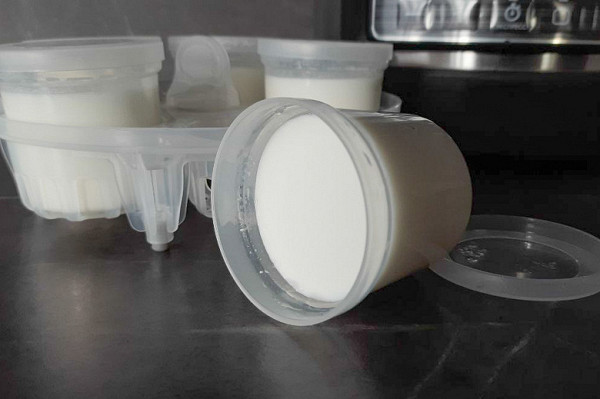
We got an excellent, thick yogurt with a delicate consistency.
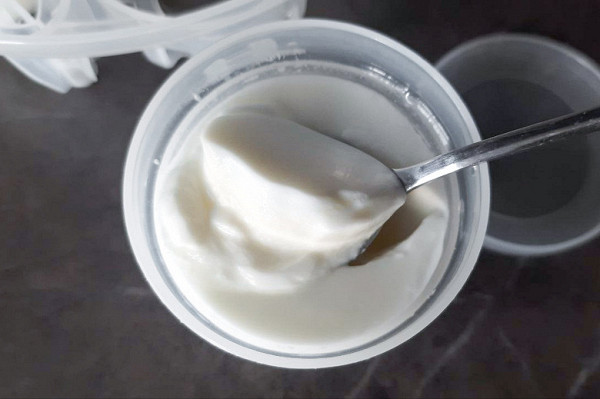
Result: excellent
Buckwheat porridge
In this test, we checked how effectively the Express program works, designed for cooking crumbly porridges in water. It automatically detects the moment when all the liquid has boiled away and turns off the heating.
We took the valve out of the lid, poured 200 g of pre-washed buckwheat into the bowl and poured 400 g of cold water. Then we closed the lid and started the program.
After 10 minutes, a quiet melodic signal was heard. We opened the lid and found ready crumbly porridge: the cereal was not overcooked, and nothing stuck to the bottom.
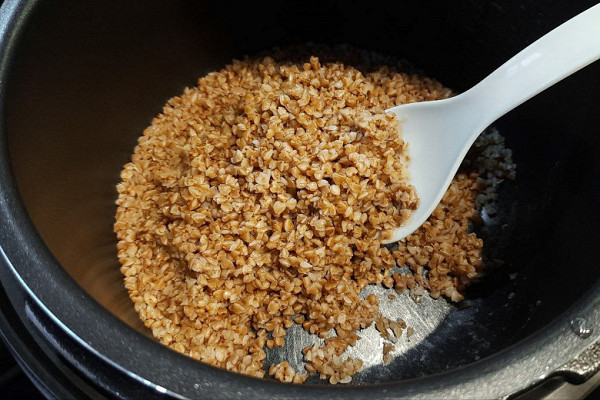
Result: excellent
Cutlets
In this test, we checked the Frying mode and the uniformity of the bottom heating. By default, the program sets the maximum temperature to 180 degrees and the time to 18 minutes. After 1.5 minutes, the multicooker reached the operating temperature, and the countdown began. We put the cutlets on the bottom of the bowl and continued to observe with the lid open.
The cooking speed immediately raised our doubts: the temperature, according to the pyrometer, was only 135-150 degrees, which is lower than stated. Nevertheless, as a result, we got an appetizing crust, and the entire frying process was quite fast.

The uniformity was also not ideal; frying occurs fastest closer to the front and back sides of the multicooker.

Result: almost excellent
Bread
In a separate container, we mixed a ready-made mixture from a trusted manufacturer with a portion of dry yeast, added a tablespoon of vegetable oil and water at room temperature. Then we kneaded the dough thoroughly.
The bowl was lightly greased with vegetable oil and a not very attractive lump of dough was placed on the bottom. After that, we closed the lid and selected the Yogurt/Dough mode for 1 hour.
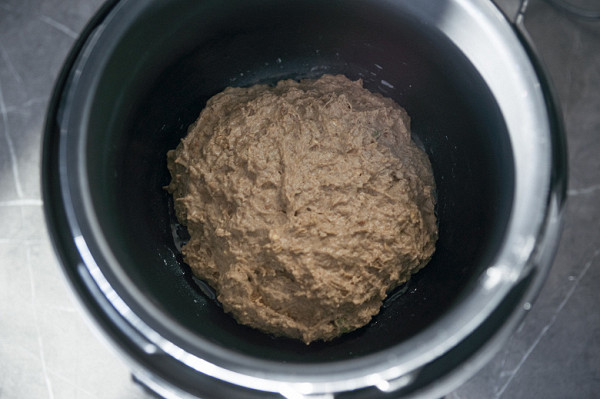
During this time, the dough has straightened out, increased in volume and become airy.
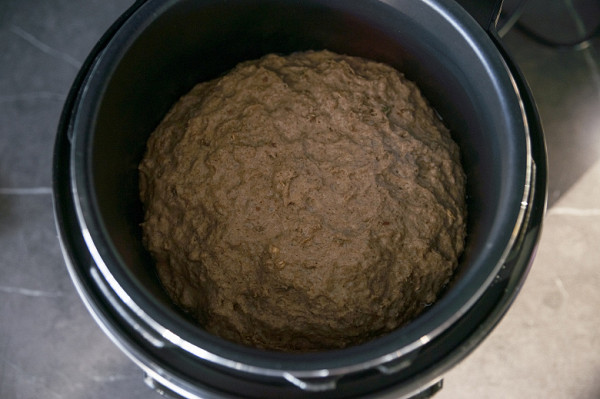
We kneaded it right in the bowl, then closed the lid again and set the Bread program. By default, it lasts 3 hours: during the first one, there is proofing, and then baking. 20 minutes before the end, we opened the lid and turned the loaf over.
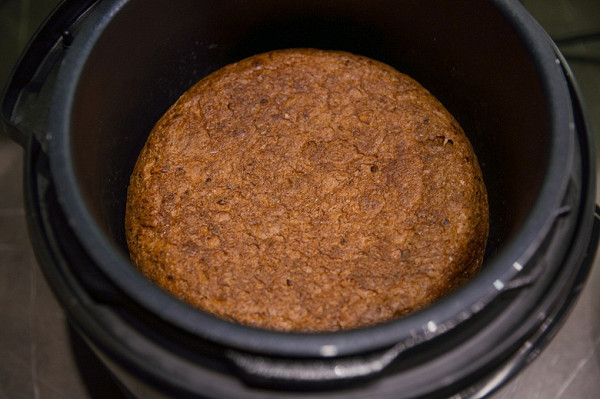
After the final signal, we took the fragrant bread out of the bowl. We wrapped it in a towel and placed it on a metal stand (the one for the steam container) so that the bottom crust would not get wet when it cooled.
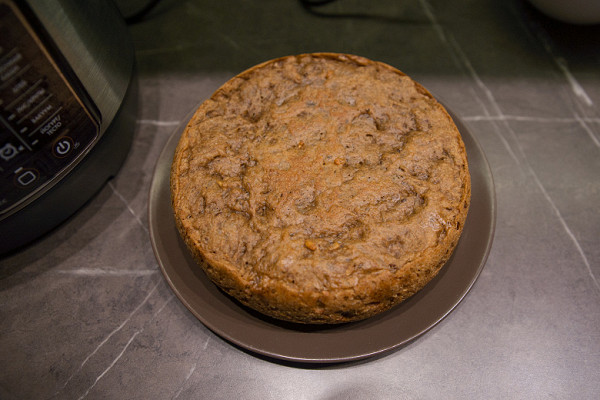
The bread turned out to be soft, springy, with a good fine-pored structure and an appetizingly baked crust.
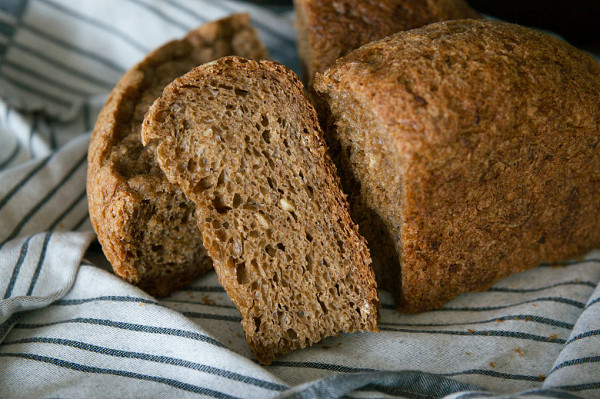
Result: excellent
Boiled beef tongue
Finally, we move on to the pressure modes. To test the Stewing program, we prepared a beef tongue weighing 1.5 kg. We washed it thoroughly, placed it in a bowl, added allspice peas, bay leaf and salt, several onions and filled it with water. It turned out just up to the Max mark.
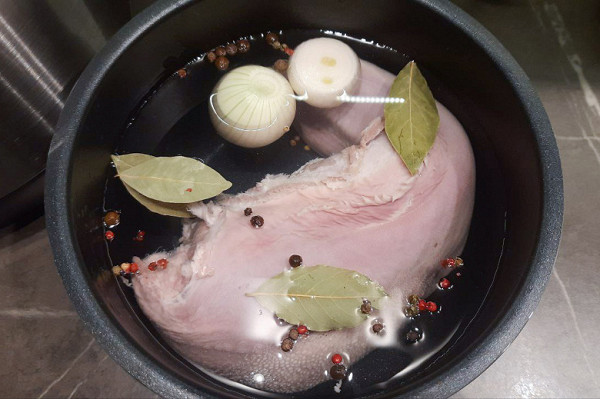
We placed the bowl in the chamber, closed the lid and selected the Braising/Aspic program. Taking into account the weight of the tongue and recommendations from proven recipes, we set the time to 1 hour.
After about 20 minutes, the device built up pressure, released steam several times and began the countdown. What was the result? Rich broth and perfectly cooked tongue.
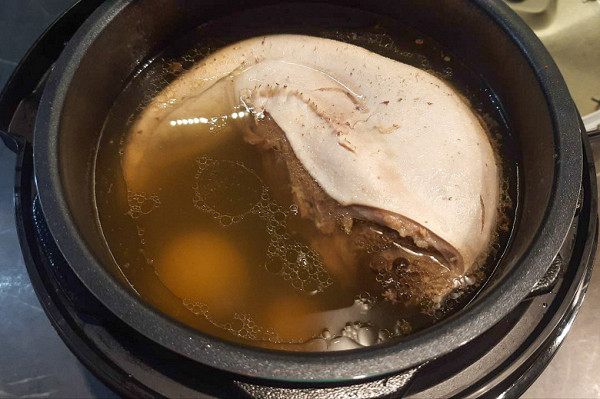
It was not overcooked and had an excellent consistency. We dipped it in ice water and started cleaning it a minute later.

Result: excellent
Beet
We took 1.2 kg of medium-sized beets and decided to boil them in the Soup mode. We filled the bowl with water, turned on the program and set the time for 15 minutes. After finishing the work, according to the instructions, we waited 5 minutes, then released the steam and opened the lid. The water continued to boil for about 10 seconds.
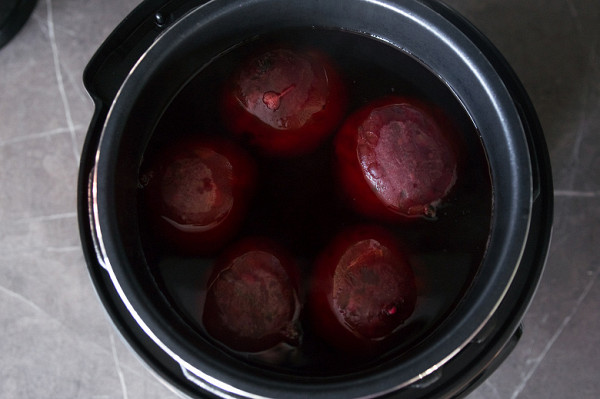
The root vegetables were cooked perfectly, with no raw spots. Although the process took 40 minutes instead of 15 due to the pressure build-up and the time it took to cool before releasing the steam, it was still faster than usual. And you don't have to worry about watching the pan to make sure the water doesn't boil away, lowering the temperature, or checking the vegetables' readiness with a knife.
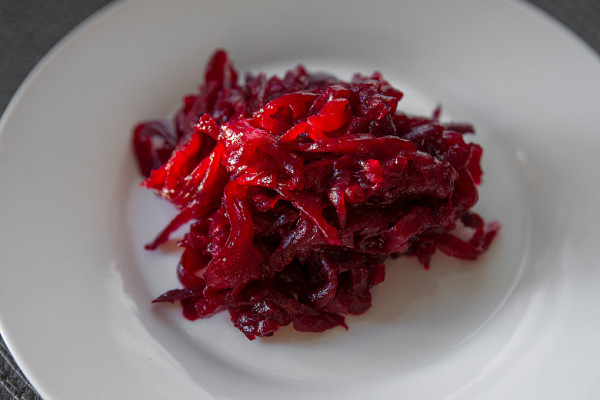
Result: excellent
Conclusions
This Redmond multicooker-pressure cooker offers a well-chosen set of programs, most of which allow you to adjust the parameters, which significantly increases the functionality of the device. The automatic programs are initially set up wisely, so even a novice cook will find it easy to cook. Although there are enough programs and nuances, all of them are explained in detail in the instructions, and there are no questions.
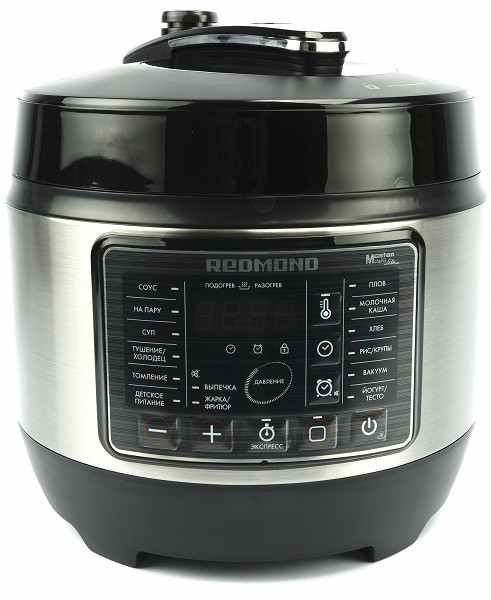
The process of setting the time and temperature in the Redmond RMC-PM504 is convenient and logical, the wide range of possibilities pleases: it can make yogurt at a minimum heating of 35-38 degrees, as well as bake and quickly fry.
Cooking under pressure fully met our expectations, significantly speeding up the process compared to a regular multicooker and, especially, with a saucepan on the stove. Important advantages include a four-level protection system when working with pressure: pressure and temperature sensors monitor the indicators in the chamber, and if the parameters exceed the norm, the system automatically reduces them without stopping the cooking process, or turns off the device.
Pros:
- neat assembly and compact case
- excellent test results
- well-thought-out automatic programs
- four-level protection system
- timer, lock and switchable sound signals
Cons:
- no significant ones found
